We humans are funny creatures. We don’t always act in our own best self-interest. And when we get into groups we don’t always make better decisions. Sometimes we build entire organizational practices that are nonsensical, counterproductive, anachronistic, and/or that we ourselves would not want to be subject to.
Case in Point; Performance Management.
In an evolving workplace there is a growing trend suggesting end-of-year performance reviews are no longer effective. According to a Deloitte Insights survey, 58% of the companies polled reported that they view their current performance management process as not being an effective use of time and only 8% reported that their process drives high levels of value. To remedy this, some companies have decided to utilize software to improve their process. Other companies have elected to eliminate reviews altogether.
That begs a question.
What is the most effective performance management approach to encourage high performance year-round?
To answer, let’s take a user perspective rather than a managerial perspective. After all, they should be the same thing, right?
It’s always a good idea to start with the client in mind and, under this perspective, the contributors we are seeking to encourage to high performance would be our clients.This perspective can be best understood by the concepts of Servant Leadership.
Here’s an overview of servant leadership if this term is new to you.
What’s My Motivation?
Most performance management techniques revolve around 2 axis; rewards or penalties. On the rewards side we can call it salary, bonus, compensation, or whatever. But generally people are incentivized to high productivity via rewards. The flip side are penalties which could range from reduction or absence of rewards to reduced or eliminated security, status, and stability.
But is that carrot and stick approach the best system to use?
Turns out the science says ‘no.’
Autonomy, Mastery, and Purpose
In Daniel Pinks excellent book Drive: the Surprising Truth About What Motivates Us (and eponymous TED Talks), he reveals that the research say unequivocally no.
Rather than re-state Pink’s message (see above 10 min video for a great overview); Rewards don’t work the way you’d expect them to.
It turns out that after a certain amount of compensation, rewards are actually counter-productive in terms of increasing performance in any endeavor requiring a modicum of cognitive skill. After that magic level of compensation, people require other attributes to be present in order to
Got that?
In other words, if you want higher performance, you have to pay people enough where they aren’t worried about money but then you have to enable 3 other key attributes; autonomy, mastery, and purpose.
Thus, the overwhelmingly most popular way of incentivizing performance, reward vs penalty, is wrong.
And, if you want to maximize performance, it turns out that you must optimize for motivation.
So, how does one do that?
What’s the right way to handle performance management?
If rewards are wrong (or at least only part of the story), then it seems we’d best change our performance management process to the other key factors Pink identifies; Autonomy, Mastery, and Purpose.
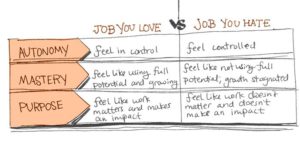
Let’s take each one step by step.
Purpose
Per Pink, Purpose is each team member being able to say “I know why I am here and what I contribute with (as an individual or as a team)”
How do we maximize a sense of purpose?
So, as managers with a strong background in quality and strategic deployment techniques seeking to maximize performance, how do we maximize a sense of purpose?
I like Simon Sinek’s approach of ‘Start with the Why‘
Again, if you haven’t seen this Ted talk, you’re missing out.
To my mind, conveying Why is all about alignment. Alignment between the strategic direction of the company and the front-line personnel executing the vision.
Some techniques quality leaders can use that we can use to achieve, communicate and measure that alignment are:
If we want to maximize performance management, it behooves us to make the alignment of why behind what people are being asked to do explicitly clear.
There is nothing so useless as doing efficiently that which should not be done at all
–Peter Drucker
Often, when we make that alignment clear we find that much of the resources of time, talent, and energy that people are currently expending are in pursuit of things that don’t matter or don’t matter as much as other goals they could be working towards. And that is clearly a waste.
Mastery
If the next attribute in results is Mastery, then it makes sense to incorporate this into our performance management techniques.
How can we best help people pursue and achieve mastery of their professions?
Some tools we can use to monitor and maximize mastery are visual management principles and gauge R&R techniques. Perhaps the two that I like best are Skill Matrix boards – an excellent visual management of team skill mastery and credibility as described by Ray Dalio in Principles. However, there are countless adaptations of each that we can apply to skill acquisition.
Also, it is helpful to recognize that every member of a company has a profession (what they do) and an industry they perform it in (where they do it.) It makes sense from a performance management standpoint to help contributors to develop a strong understanding of both the skills and context for their role and their industry at large. T shaped employee management is an excellent framework for this/
Autonomy
Now that we’ve addressed how to manage clear alignment and skill acquisition – the why’s and what’s of a role – let’s move on the how’s.
Again Pink helped us by illustrating how autonomy and empowerment are crucial pieces of the performance management puzzle. And we helped ourselves by showing the alignment of the highest strategic goals of the company
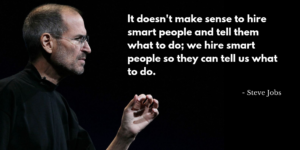
Now, autonomy is scary for many managers. To overcome this hurdle we could use a ‘trust but verify’ model of cascading dashboards and assigning responsible parties for work streams. And the autocratic manager will be happy with this. But autocratic leadership has it’s limits.

Perhaps the best way to encourage autonomy to meet our desired performance management goals is to favor the empowerment of a Team of Teams model such as the ones favored by General Stanley McChrystal (and others) in his book Team of Teams.
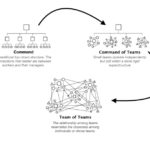
Autonomy is best served by employee empowerment.
There is a link between employee desire to participate on autonomous teams and having a significant sense of ownership in team outcomes. Simply put, members of autonomous teams desire the ability to make decisions in an entrepreneurial climate without too much managerial interference.
-Source: James Hess, Ivy Business Journal.
And arguably employee empowerment is best achieved through managers leading by illustrating a clear vision and then getting out of their way.
Bringing it All Together
As leaders it is important for us to recognize that performance management is itself a process. It’s subject to an equation Y=f(x) where f(x) is often more complex than we think.
But fortunately, like any other process, it can be measured, faults found, and hypotheses tried, tested, and improved upon.

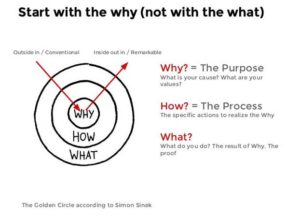
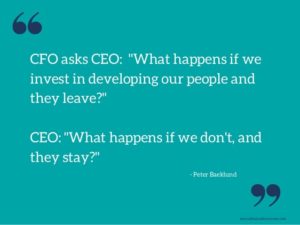

Comments (2)
Really well done article. I like how the performance framework references other frameworks (i.e. Start with Why, Team of Teams, etc.) AND ties in where Lean Six Sigma techniques can be used to execute.
Thank you, Laura. Much appreciated!